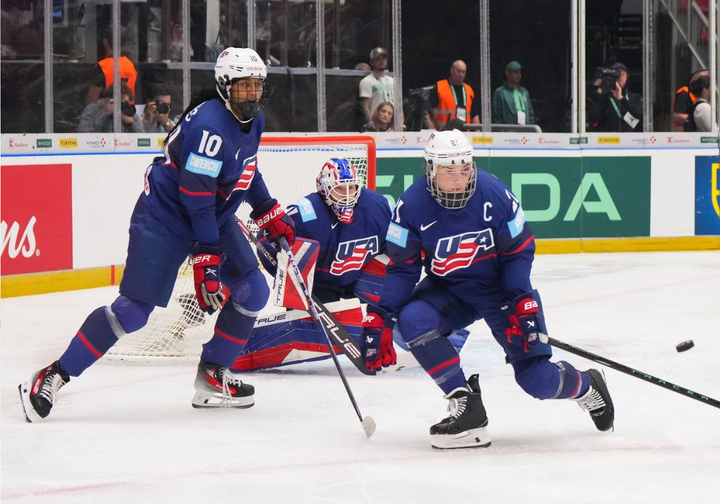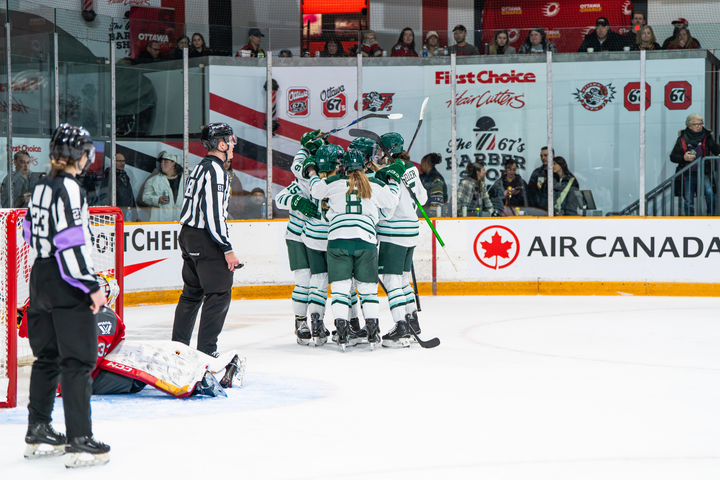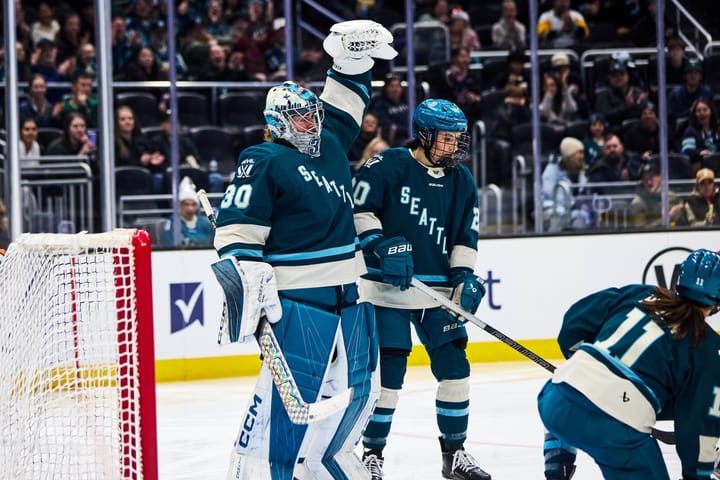2017-18 NCAA Preview: 5 storylines to follow
North Dakota players scatter, the NCAA looks ahead at expansion, and some top goalies to watch this year.
WCHA Crowd-Funding Efforts
In July, the WCHA announced it would begin a crowd-funding campaign to raise funds for the conference. Commissioner Katie Million called an attempt to think outside of the box in terms of funding.
“We're just trying to be proactive. As schools get less funding, their budgets are tightening. We just want to do everything we can in our power to lessen the burden of what they need to pay us financially,” she said at the time.
This came just four months after University of North Dakota announced it would be cutting their women’s hockey team due to budgetary issues. According to reporting in the Star Tribune, the Minnesota Golden Gophers, one of the most popular and successful teams, operates at a net loss of about $2 million a season.
The operating budget of the WCHA is about $700,000, with around 80 percent coming from the dues from each school. In 2015-16, the dues were $87,000 per team but that will most likely go up with UND departing.
The WCHA, which was already a 501(c)3 nonprofit, set up the crowdfunding through a popular site called RallyMe. They set up goals to raise money for various aspects such as operations funds, the conference tournament, scholarships, and awards.
A few weeks later, the league announced its first partnership. GoodWood Hockey will be sponsoring weekly and monthly awards.
To date, that has been the largest announcement. At the preseason conference call, Million said it was not an essential crowdfunding campaign but called it a capital campaign and echoed the same proactivity from the initial announcement earlier in the summer.
It will be interesting to see how this campaign goes. They have lofty goals of anywhere from $5,000 to $50,000. The RallyMe site shows slowing going on the public facing side, with no one campaign having more than $3,000. I doubt it will be trend to be fearful in women’s hockey, but is an interesting story to see how it plays out over the season.
"Wins" from crowdfunding: Most folks didn't know the WCHA was a 501c3 before this campaign. It has given them huge exposure, as well.
— Nicole Haase (@NicoleHaase) September 12, 2017
Expansion Complications
As with many NCAA sports, teams come and go from the Division I ranks every season. The biggest news coming from the eastern US was Holy Cross deciding to bring their program to Hockey East beginning in 2018-19. The Crusaders will become the tenth team in the New England based conference and the first new team to join the conference since Merrimack went DI in 2015. Both Holy Cross and Hockey East have made it clear they are excited about this new relationship.
A notable difference between Merrimack and Holy Cross is the preexisting status within Hockey East of the Merrimack men’s hockey program that allowed them to enter the conference immediately. Holy Cross is taking something of a bridge year in 2017-18 before become a full-time conference member in 2018-19.
For the 2017-18 season, Holy Cross will be playing a schedule of DI opponents such as New Hampshire and Harvard, as well as familiar DII opponents like St. Anselm and Franklin Pearce. As our friends at BC Interruption have pointed out, this may cause issues for the NCAA tournament selection in March.
Due to the women’s NCAA tournament’s status as a National Collegiate tournament, all DI and DII teams technically compete for the same tournament spots. Two of the requirements for tournament elgibility were a sufficient RPI (more on that later) and at least 20 games played against DI/DII opponents. In the past, DI independents and DII schools nearly exclusively played DIII teams, and everyone was able to ignore this flaw in the system. Enter the scheduling alliance created by Holy Cross, Post, Sacred Heart, Franklin Pearce, St. Anselm, and Saint Michael’s. This is effectively a fifth conference within the NCAA, and just so happened to have each team play each other 20 times.
Not only does this suddenly make all of the teams eligible for the tournament, but it creates an issue with the way RPI (Ratings Percentage Index) functions. RPI works by comparing success of each team based their record against common opponents. The reason RPI is able to work on a national scale is because there are enough teams crossing over and playing out-of-conference opponents with regularlity. The spiderweb of connected teams gives RPI a solid statistical base for the selection committee to use.
Most of these teams will have no connecting teams outside of this pseudo-conference, so RPI will be forced to treat them as average opponents, even though they are still just above the DIII level of competition.
What does this all mean for Holy Cross?
The Crusaders will have a relatively soft schedule set up for them before their inaugural Hockey East season. With the limitations of RPI, they may emerge as a “top” team in the standings by the end of the season. Ultimately, Holy Cross will need to use this season to fine-tune themselves before entering the rigor of a full DI schedule in 2018.
On the flip side, one of the premiere programs in the country, UND, ceased operations this March.
While we have already discussed this, it has caused a new wrinkle in the NCAA this season...
North Dakota Players are Dispersing
The NCAA allowed all Fighting Hawks to transfer immediately and bypass the regular one-year waiting period. This means the entire team has been given free rein to go wherever they can find a roster spot. Brad Elliot Schlossman has compiled a list of landing spots for nearly every player and commit that chose to depart. At the time of the list, only two current roster players hadn't yet announced their new schools: Sophomore forward Dorci Medgyes, the first ever NCAA athlete from Hungary; and freshman Annalise Rice, who was dealing with a family lawsuit at the time the program disbanded.
There’s also goaltender commit Lauren Hennessy, who was on an official visit with UND as the news broke.
did it mention I'm from Boston and flew out at 5:00 am this morning as a hockey commit?
— Lauren hennessey (@hennessey4229) March 29, 2017
Four other 2018 commits have yet to find new homes as well.
The vast majority of players and commits did indeed find new homes, mostly notably Ryleigh Houston, who is now a Minnesota-Duluth Bulldog. Other athletes staying within the WCHA include Rebekah Kolstad (Minnesota State), Hallie Theodosopoulos (St. Cloud State), Abby Thiessen (St. Cloud State), Charly Dahlquist (Ohio State) and Kristen Campbell (Wisconsin). Theodosopoulos is from South Dakota, Kolstad and Campbell are from Minnesota, Theissen is from Alberta and Houston and Dahlquist are from Manitoba, so it would make sense they would all stay local.
Then there are the three Finnish national team players: Emma Nuutinen, Vilma Tanskanen, and Anna Kilponen, who all competed in the 2014 Winter Olympics. Nuutinen and Tanskanen both transferred to Mercyhurst alongside redshirt freshman goaltender Kennedy Blair. The newest Lakers will have a chance to make an immediate impact in the CHA, where Mercyhurst will attempt to overthrow Robert Morris. Kilponen transferred to Quinnipiac and gets to play in the very competitive ECAC.
Defensemen Abbey Stanley and Taylor Flaherty both transferred to Hockey East schools, Stanley going to Boston University and Flaherty going to Vermont. Sarah Lecavalier will join Robert Morris, and Alyssa MacMillan and Breanna Berndsen went to CIS schools.
The Finnish team players are the most likely to make a big impact given their track record in high pressure environments. Houston easily has the best college track record of any former Fighting Hawks and will get to play in a WCHA conference missing a lot of star players. The recruits now looking for new schools will likely find new landing spots, but this situation is less than ideal if you are a high school student.
Centralization Losses
Between Team USA and Team Canada, five colleges will lose active players due to centralization ahead of the Olympics: Minnesota, Minnesota-Duluth, Wisconsin, Boston College, and Cornell. The Eagles, Badgers, and Golden Gophers all are without two players while the Bulldogs and Big Red will each lose one.
Wisconsin might feel the biggest impact of centralization. Along with losing top recruit Sophie Shirley to the CWHL for the upcoming season, the Badgers lose rising seniors Annie Pankowski (USA) and Emily Clark (CAN). Their 2017-18 rosters is extremely young, with eight freshman, eight sophomores and only nine total juniors and seniors. They will miss that veteran presence of both as well as Pankowki’s goal scoring. She was second in the nation in goals last season with 25.
Minnesota will lose some serious offensive fire power as well. Kelly Pannek (USA) and Sarah Potomak (CAN) accounted for 23 percent of the Golden Gophers’ goals and 37 percent of the assists last season. The WCHA coaches voted for Minnesota to finish first in the conference in their preseason poll. The preseason rookie of the year, Grace Zumwinkle, will look to have a big impact early in her collegiate career. A standout high school player, she had 42 goals in 23 games in her senior season.
Minnesota-Duluth will definitely miss their junior goaltender Maddie Rooney (USA). She logged 2250:42 minutes between the pipes for the Bulldogs last season. With a save percentage of .942, that’s a lot to make up for.
The Bulldogs did add a Mercyhurst transfer of Jessica Convery. She saw a majority of the minutes in net in the 2016-17 season with a save percentage of .911. Last season’s backup goalie, sophomore Catherine Johnson, will look to have a larger role with the team as well.
Cornell will lose a strong defensive presence in Micah Zandee-Hart (CAN). As a sophomore she was the team captain. A multi-tool player, Zandee-Hart is an offensive defender, leading the team last season in power play goals and power play points. She was third on the team in goals with five goals and third in points with 16. The Big Red will miss her on the power plays and penalty kills for sure.
Boston College could be the least impacted, if only because of senior defenseman Kenzie Kent and senior goaltender Katie Burt. While losing Megan Keller (USA) and Kali Flanagan (USA) will definitely hurt their defensive core, the rest of the Eagles roster looks solid. That’s not to say Keller and Flanagan won’t be missed: Flanagan is perhaps one of the most underrated players in college hockey right now, and Keller is, well, Megan Keller.
Senior Goaltending
There’s no shortage of really really good goaltending this season, even thought two of last season’s top 'tenders are gone. Reigning Patty Kaz winner Ann-Renée Desbiens graduated and Maddie Rooney centralized with Team USA. But a fresh crop of senior goaltenders are looking to make a stand.
You can’t not talk about Boston College’s Katie Burt. The assistant captain is only 20. She was the first overall draft in the NWHL Draft this year and her save percentage last season was .935, sixth in the nation. With a strong defensive core in front of her featuring Kenzie Kent, look for this Eagle to help her team soar back to the National Championship this season.
With 1135 saves last season, Ohio State’s Kassidy Sauvé is another one to watch this season. The WCHA was hit hard by centralization and Ohio State has a chance to be the dark horse of the conference with Sauvé in net.
Clarkson’s Shea Tiley returns following an outstanding Frozen Four Finals game. In the final game of last season, Tiley shut out offensive powerhouse Wisconsin. It was one of six shutouts she had on the season. If Clarkson’s wants to repeat, Tiley will have to have another standout season.
Lost among these big names might be Abbey Miller of Syracuse. In the 2015-16 season, she saw 137 minutes between the pipes. In 2016-17, she saw 1827:34, a huge jump in workload. She embraced the challenged and excelled: she was second in the nation with shutouts (9) and earned the CHA Goaltender of the Year award.





Comments ()